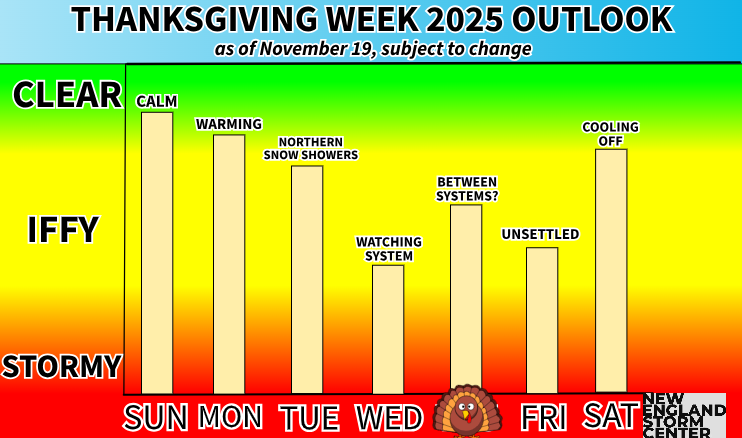Deep Trough to Send Cold Fronts Through New England Late This Week
- Tim Dennis
- Sep 3
- 3 min read
After another stretch of dry and quiet weather for New England, the region's next shot at more active weather will come Thursday night through Sunday morning. Multiple rounds of showers and storms will be possible during this time frame as a deep trough forms across the Midwest and Great Lakes regions. This trough will send multiple cold fronts and shortwave disturbances through New England to close out the week, bringing a widespread, beneficial rainfall for much of the region.
Below: 500mb height anomaly late this week, showing the deep trough centered over the Great Lakes:

New England's first round of showers will come Thursday night into Friday morning as the first cold front pushes across the region. This cold front will likely weaken and fall apart across New England. The best shot at widespread showers and a good rainfall will be across the western half of New England and northernmost areas, before the front dies out. Additional showers will be possible Friday afternoon, but many areas may stay dry during this time. Friday has certainly trended drier through the week as the main cold front has been pushed toward Saturday.

After Friday's front, the trough's main cold front will swing through New England Saturday through Sunday morning. A secondary area of low pressure may form along this front, which would help to create a more widespread rainfall instead of just scattered showers, but the strength, timing and whether this occurs remain questions.
Either way, the higher chances of a longer lasting, steady rainfall on Saturday will be across western and northernmost New England. Areas east of the Connecticut River and south of the mountains are currently more likely to see a period of scattered showers and thunderstorms Saturday afternoon and evening rather than periods of rain all day.

With these rounds of showers and storms centered over western and northernmost New England, those are the areas that will see the most amount of rainfall through Sunday morning. With the potential for an area of low pressure to form along the front, interior Maine may end up being the jackpot zone for rainfall as this area would have the most time for the low pressure to develop.
A widespread 0.25-0.75 inches of rain is likely across New England from Thursday night through Saturday night. The biggest question in where exactly the most rain will fall has to do with the front's timing. The cold front looks rather progressive, so if it trends faster over the next 36-48 hours, the heavier rainfall totals will be pushed south and east.

Along with the rainfall, this system will bring a surge of summer-like temperatures and dew points to the region. Ahead of the cold fronts will see a moist, southerly flow develop, increasing humidity from their persistently low levels. The humidity will peak on Saturday ahead of the main front.
Friday night looks to be warm and breezy, likely the warmest night New England has had in a couple weeks. Dew points will likely be well into the 60s on Saturday with widespread 80s for high temperatures. Both temperatures and humidity will be on the downfall on Sunday once the front clears the region.

This trough is a very deep one, which will be centered over the Great Lakes and Midwest regions. This will bring very chilly temperatures to the central United States through the end of this week. New England will be on the edge of this trough, so temperatures here will remain close to seasonable through this week with a surge in temperatures ahead of the cold front Saturday.
Below: Temperature departure from average Saturday afternoon, showing October-like air across a large portion of the United States. You can probably tell where the cold front is across the eastern United States:

The dynamics of this trough are interesting for September, as it involves a cross-polar flow. With a highly amplified ridge in the west and another ridge farther east extending toward the North Pole, the trough in between will see a corridor open up, allowing flow from across the Polar-region into the central United States. This setup brings the United States its most severe arctic blasts of each winter. Given its early September, the effect is naturally muted, but it will be quite chilly given the time of year for the Midwest.
Below: 500mb height anomaly mean from September 3 to September 8, showing what is described in the above paragraph:

With the slower overall trend in the main cold front's arrival, some showers may linger across southernmost and easternmost New England into Sunday morning. Both humidity and temperatures will be dropping off through the day as the new air mass settles in behind the front. It won't be as chilly for New England next week as it will be over the Midwest this week and weekend, but generally cooler temperatures will persist after the fronts.
Below: Temperature departure from average on Sunday afternoon:




Comments